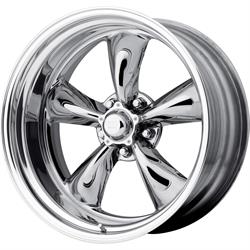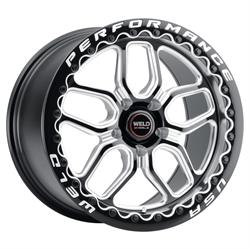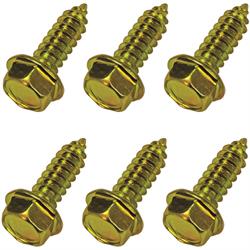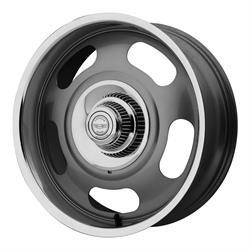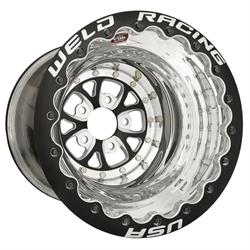Best Wheels for Drag Racing | Lightest Drag Wheels & Beadlocks
Drag racing, as we know it, began when a group of automotive enthusiasts looking to push the limits of speed unleashed their high-performance cars on the open roads of Southern California and Utah’s sweeping Bonneville Salt Flats. But it wasn’t until 1950, when CJ “Pappy” Hart organized the first commercial drag race at Orange County Airport, that the sport officially took off. Five years later, the American Hot Rod Association (AHRA) was established, helping to fuel the sport’s growth, and giving rise to a tight knit but dedicated fan base. Over the decades, drag racing would spread like wildfire, reaching major cities across the U.S., and becoming a staple of American motorsports, eventually exploding into the nationwide phenomenon it is today.
Back in those formative years, “racing” wheels were usually borrowed from passenger cars–we’re talking vintage steel wheels and hubcaps. But as demand for more performance-oriented setups picked up, manufacturers like Halibrand and American Racing Wheels stepped in to fill the void. The next several decades saw a surge of innovation, from lightweight aluminum designs that could fit larger tires, to the classic 5 spoke muscle car wheels design popularized by American Racing’s Torq Thrust Wheels and Cragar’s SS wheels, to the stronger yet lighter forged aluminum wheels that became the go-to for serious racers throughout the ’80s and ’90s.
This focus on strength extended into modern racing wheels, with advanced technologies like flow-forming and pressure casting entering the picture. These methods produced better-performing parts without sacrificing weight or durability, a boon for professional drag racers and muscle car modders alike. Over time, drag racing wheels have become the quintessential blend of form and function, especially for hot rods and modern muscle cars. Many of today’s wheels feature larger diameters to accommodate wider tires for improved grip and stability, yet with sleek and aggressive designs that feed enthusiasts’ desire for an eye-popping ride.
Finding the Best Type of Wheels for Drag Racing
How to find the best wheels for drag racing–it’s a tall task given the wealth of current options, and the fact that new designs are being produced all the time. Besides, these wheels have to balance factors like strength, weight, fitment, tire compatibility, brake clearance, and compliance with different race regulations, not to mention some visual appeal and a price point that doesn’t require a second mortgage.
One way to start narrowing the field is by looking at basics like how wheels are put together (e.g., forged wheels vs cast, as well as the materials that are used to make them. Forged wheels are crafted under immense pressure using a forging machine, which aligns the aluminum's grain structure for better impact resistance and fatigue strength than standard cast wheels. This process eliminates porosity, resulting in exceptional strength and durability without compromising on weight savings. Beyond their performance advantages, forged wheels also look sharp and offer a wide range of offsets and widths thanks to their common two- or three-piece construction.
Cast wheels, on the other hand, are made by pouring molten metal into a mold. Their "monoblock" construction opens a wide variety of design possibilities, though size options may be more limited since each wheel dimension requires a unique mold for casting. They’re also more cost-effective to manufacture since there’s less processing and labor involved. Though not as strong as forged options, cast wheels are more than capable for everyday driving while capturing the iconic design cues of classic muscle car wheels.
Another point to consider is radial trueness, or how well a wheel maintains a consistent radius from the center hub to the edge of the wheel as it rotates. Why is this important? Because it helps the tire stay in constant contact with the road or track, reducing the odds of wheel spin during launches or sudden acceleration. Poor radial trueness can also lead to vibrations at higher speeds, making the car more difficult to control and disrupting the transfer of power from the drivetrain to the track. Plus, it can cause tires to wear unevenly and make wheels harder to balance.
What Are Beadlock Wheels
If you’ve been around drag racing for any length of time, chances are you’ve come across the term “beadlock” or “beadlock wheels.” In case you’re unfamiliar (or down for a quick refresher), beadlock drag racing wheels are specially designed to prevent tire slippage under extreme torque, aggressive launches, or low-tire pressure use by clamping the tire's bead securely to the wheel. It uses a bolted ring on the wheel’s outer edge—or on both edges in the case of double beadlocks—that sandwiches the tire bead between the ring and the wheel. This design not only prevents the bead from rotating during launches on sticky surfaces, but it also keeps the bead seated under the intense centrifugal forces that can cause separation at high speeds. By maintaining a secure seal, beadlock wheels prevent air loss or, in the worst case scenarios, the tire from sliding off the wheel. While beadlocks are heavier and more expensive than traditional wheels, their unmatched durability and performance benefits make them almost indispensable in high-horsepower and/or low-pressure applications, in particular drag racing and off-roading.
Do I Need Beadlock Wheels for Drag Racing?
Whether you need beadlock wheels for drag racing depends largely on the vehicle’s output and your individual performance goals. For most street cars or entry-level drag racers running street or drag radials, beadlocks may not be necessary. As power levels increase, however, the need for beadlock use grows. Around 700-800 horsepower is a reasonable starting point to consider a single beadlock, while anything exceeding 1,200–1,300 horsepower should probably take a double beadlock. Another good benchmark for beadlocks is whenever you’re running large slicks with tire pressures under 10 psi.
For National Hot Rod Association (NHRA) competitors, the guidelines are clear: Beadlocks are mandatory in Nitro Funny Car and Top Fuel, as well as Pro Stock and Factory X classes. In addition, beadlocks (or liner wheels) are required for any vehicle that exceeds 210 mph, which covers classes like Top Sportsman, Top Dragster, and Comp. Pro Mod racers are given the option to run beadlocks.
Elsewhere, the Professional Drag Racers Association (PDRA) requires beadlocks for all racers in its Extreme Pro Stock class, and beadlocks or liners for any vehicle in Pro 632 that runs 170 mph and faster, or 4.10 and quicker for the 1/8-mile. In other classes, like Radial vs The World, and X275, beadlocks are highly recommended for both consistency and safety. However, for street-strip setups or milder builds, they probably aren’t necessary unless you’re regularly approaching the high triple digits and running aggressive tires.
How Do Beadlocks Wheels Work?
So, how exactly do these specialized wheels do their thing? A beadlock ring secures to the wheel using evenly spaced bolts–usually 16 to 32, depending on the design. This holds the tire bead firmly against the wheel lip and prevents it from slipping or unseating under high torque, low pressures, or centrifugal forces. Assembly can be a little tricky, but here’s the rundown: First, you position the tire on the wheel with the bead seated over the wheel’s inner lip. For single beadlocks, the outer bead will rest on the beadlock flange. The beadlock ring is then placed over the outer bead. Next, secure the bolts by threading them into the pre-drilled holes in the wheel. Tighten the bolts gradually, in a crisscross pattern, to apply even pressure and avoid distorting the tire bead. Once all the bolts have been torqued to spec, inspect the assembly to make sure there’s a consistent seal and everything is properly aligned.
Are Beadlock Wheels Street Legal?
The legality of beadlock wheels for street use is somewhat of a gray area. We know that’s not the answer you were looking for, but here’s why it’s not so cut and dried: Traditionally, beadlock wheels have been considered race-only because of concerns over how they’re assembled and whether they’re safe for public roads. Plus, they need to be regularly maintained–e.g., checking to make sure the bolts are properly torqued, which isn’t practical for everyday use. But here’s where things get sticky.
To the question of whether you can legally use beadlock wheels on the street, well, it depends on where you are and who made them. In some states there’s nothing on the books specifically banning beadlocks, while in others, all wheels must meet DOT (Department of Transportation) safety standards for road use. A lot of beadlock wheels are designed for off-road or racing use only and aren’t DOT-certified, which makes them technically illegal on public roads in certain areas; but some designs are DOT-approved and therefore street-legal. Manufacturers like Weld Racing Wheels, for example, offer street-friendly beadlock options for dual-purpose vehicles, letting you drive to the track without having to swap wheels. So yes, it’s legal in some places and with certain brands, but probably not ideal in many situations.
Rim Screws vs Beadlocks
Before beadlocks arrived on the scene, racers often used rim screws to secure their slicks; they still do, in fact. These small, sheet metal screws are typically drilled through the wheel flange and into the tire bead to prevent slippage. Which is to say that rim screws and beadlocks basically do the same thing, just in separate ways and to different degrees.
While rim screws are cheaper, lighter, and simpler than beadlocks, they do have some significant drawbacks. Most notably, rim screws can damage tire beads, creating potential leak points. They also need to be replaced regularly, as the holes tend to strip out after a handful of applications. And they can be a hassle to remove and reinstall when switching out tires.
Beadlocks are obviously going to cost more, and they do require compatible beadlock wheel types. They also add weight to the vehicle, which may or may not be important. But the upside is that they all but eliminate the risk of tire slippage, plus they’re exceptionally durable (provided they come from a reputable manufacturer) and won’t damage the sidewall. The bottom line: Modern beadlock systems are far more effective at keeping tires planted to the rims, whether you’re running slicks vs drag radials.
Lightest Drag Racing Wheels
In drag racing, every ounce counts. Lightweight racing wheels cut down on rotational mass, allowing the car to accelerate faster and handle better, especially during launches and at high speeds. They also put less strain on the drivetrain, delivering more of the engine’s power to the pavement. Plus, reducing unsprung weight allows the car to handle bumps and uneven surfaces better, which improves traction and the car’s overall stability.
Celebrated for their strength and lightweight design, Weld Draglite wheels stand out with their polished aluminum face and eight distinctive lightening holes. From the same nameplate, the Weld Racing Belmont Drag Series Wheel features a flow-formed design that’s built for both strength and weight savings. It combines classic styling with the performance required for high-speed racing applications. Another option is Torq Thrust style wheels from American Racing. These wheels are made from lightweight yet durable cast aluminum. Its iconic design is a great complement to any American-built hot rod or muscle car. Another great pick for modern muscle cars is the Race Star Wheels 92 Series. These wheels are specifically engineered for drag racing and feature a lightweight yet durable construction that scores high marks for both performance and appearance.
Best SFI Certified Wheels for the Track
Safety is non-negotiable in drag racing, and certification by the SFI Foundation Inc. (at one time created by SEMA and called the SEMA Foundation Inc.) means wheels have been laboratory tested and proven to meet strict standards required for high-speed driving. For classic muscle cars, hot rods, and modern muscle cars, choosing the right SFI-certified wheels can be a factor in both performance and safety. Speedway Motors carries a number of SFI-certified wheels from top brands like American Racing, Race Star Wheel, and Weld drag racing wheels. Whether you’re running slicks or radials, choosing SFI-approved wheels brings peace of mind that your equipment won’t buckle under pressure. They’re also required in many racing series and classes, including the NHRA’s Top Fuel, Funny Car, Pro Stock, Top Alcohol Dragster, Top Alcohol Funny Car, and Pro Mod, among others.
Best Wheel Offset for Racing & Racing Wheel Size
Finally, we come to wheel size and offset, both of which play a vital role in the performance of drag racing wheels. A larger wheel diameter can accommodate a wider tire, which increases the contact patch between the tire and the track. Although they help provide better traction, the tradeoff is that larger wheels naturally add weight. Deciding what’s more important depends on the individual, unless you’re competing in classes with specific tire rules, which will limit the choices. That said, racers generally opt for narrow front runners to minimize weight and rolling resistance, and wider rear wheels to maximize traction.
Wheel offset refers to how the wheel sits in relation to the hub–it’s measured from the hub mounting surface (the point where the wheel attaches to the hub) to the centerline of the wheel. A negative offset, which pushes the wheel outward, provides more track width for better stability. By distributing weight evenly across the rear tires, the proper offset helps prevent things like wheel hop or instability under hard acceleration. As you probably guessed, a positive offset pulls the wheel inward and has essentially the opposite effect.
In addition to impacting traction and stability, offset can affect areas like suspension geometry. If the offset is, well, off, it can interfere with control arms, shocks, brakes, and other nearby components and prevent the suspension from effectively managing weight transfer. Offset also determines where the wheel sits within the wheel well, which means if it’s too far one way or the other you’re risking potential damage to the frame or fender. To ensure your wheels fit perfectly, check out our guide on how to measure backspacing on wheels before making your purchase.
Because getting wheel size and offset are so important, Speedway Motors has also developed a specialty tool to help you find the perfect fit for your setup. WheelWise™ is a wheel sizing tool that allows you to quickly and easily measure for wheel backspacing, width, and diameter using the actual tires that will go on the vehicle for an accurate mockup and perfect fitment.
